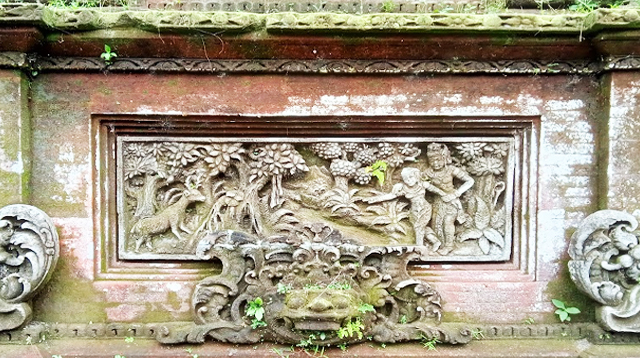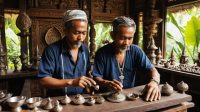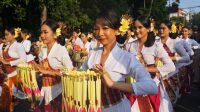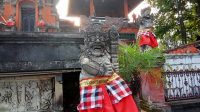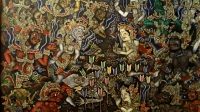THE Island of Bali, also known as the “Island of the Gods,” does not only amaze with its natural beauty, but also with its deep cultural richness. One of the most prominent and fascinating aspects of culture is the carvings and ornaments that adorn the walls of sacred buildings, especially temples. Every detail, from the material to the motifs, is not just decoration, but a reflection of the Balinese people’s philosophy of life that is one with nature and spirituality.
Natural Materials: The Beauty of the Land of Bali
Sacred ornaments in Bali are mostly made from natural materials typical of the Island of the Gods. Paras aon stone (gray tuff) is the main choice often used. The relatively soft texture of this stone makes it easy for artists to carve it into smooth and detailed reliefs. Its neutral gray color also gives an elegant and unobtrusive impression, highlighting the shape of the carving itself.
In addition to paras aon, red brick is also commonly used, especially on certain parts of the wall or as a base for stone carvings. The combination of natural gray and brick red colors creates a harmonious contrast, strengthening the aesthetics of the sacred building.
The process of making these ornaments involves high skills from the undagi (traditional architect) who have inherited this expertise from generation to generation. They understand the character of each material, ensuring that the carvings are not only beautiful but also durable, considering that sacred buildings are eternal places for worship and ceremonies.
Flora and Fauna: The Beauty of the Universe in Carvings
The philosophy of Tri Hita Karana—the harmonious relationship between humans and God (Parhyangan), fellow humans (Pawongan), and nature (Palemahan)—is strongly reflected in the temple ornaments. The sacred walls are brought to life with depictions of the beauty of the universe through flora and fauna motifs.
- Flora: Leaves, lotus flowers, vines, and various forms of plants are depicted in stunning detail. The pepatran motif is one of the most common, a stylization of repeated and intertwined leaves, often functioning as a closing frame or filling empty space. These murals are not only aesthetic, but symbolize fertility, growth, and the continuity of life. The lotus flower, for example, symbolizes purity and enlightenment, growing in the mud yet remaining beautiful on the surface.
- Fauna: Various animals, both real and mythological, also often appear. Birds, fish, turtles, and elephants are carved in detail that show awe of God’s creation. Each animal has its own symbolic meaning in Balinese Hindu cosmology.
These depictions of flora and fauna remind people that humans are an inseparable part of the universe. Through these ornaments, the beauty of nature is immortalized and honored as a manifestation of divine power.
The Ramayana Epic: Moral Stories and Life Philosophy
One of the main attractions on the walls of the shrine are paintings or reliefs that take inspiration from the Ramayana and Mahabharata epics. These epic stories are not only entertainment, but also a means of conveying life philosophies and moral teachings.
For example, scenes from the exile of Rama, Shinta, and their brother Laksamana in the forest are often immortalized in temple reliefs. These reliefs can depict Rama hunting, the humble Shinta in exile, or their interactions with forest creatures. These depictions are not only about the storyline, but also about the values contained therein: loyalty (Shinta to Rama), sacrifice (the Admiral who faithfully accompanies his brother), patience in facing trials, and the importance of dharma (truth and virtue).
Through these reliefs, worshippers are invited to reflect on these values, internalize them, and apply them in their daily lives. The walls of the temple become a visual “book” that teaches ethics and morality from generation to generation.
Mythological Creatures and Protectors: Boma as Guardians
In addition to flora, fauna, and epic scenes, supporting ornaments in the form of mythological creatures are also very important in the structure and philosophy of the temple. One of the most prominent is Boma.
Boma (often also called Kala Boma or Banaspati Raja) is a giant figure with bulging eyes and thick hair that is usually carved above the entrance to the temple, candi bentar, or kori agung. Boma is the son of Lord Vishnu and Goddess Pertiwi (Earth).
He symbolizes the energy of the earth that guards and protects. Philosophically, Boma is a guardian of negative things and evil energy from entering the sacred area. He also symbolizes the powerful force of nature, a reminder of the importance of maintaining the balance of the cosmos. The presence of Boma and other mythological creatures, such as dragon (symbol of fertility and underground power) or Garuda (Vishnu’s vehicle, symbol of freedom and wisdom), serve as spiritual guardians. They do not only protect the building from destructive physical forces, but also from harmful spiritual influences, ensuring that the temple area remains sacred and conducive to worship.
Through a combination of natural materials, depictions of the universe, epic stories, and mythological creatures, the walls of sacred buildings in Bali are more than just physical structures. They are eternal canvases that recount the philosophies of life, moral teachings, and spiritual beliefs of the Balinese people.
Every carving is a prayer, every relief is a lesson, and every detail is a reflection of the harmonious relationship between humans, nature, and God. Visiting a temple in Bali is not just about seeing beautiful architecture, but also about delving into the depths of philosophy and culture that have been passed down from generation to generation. (*)



